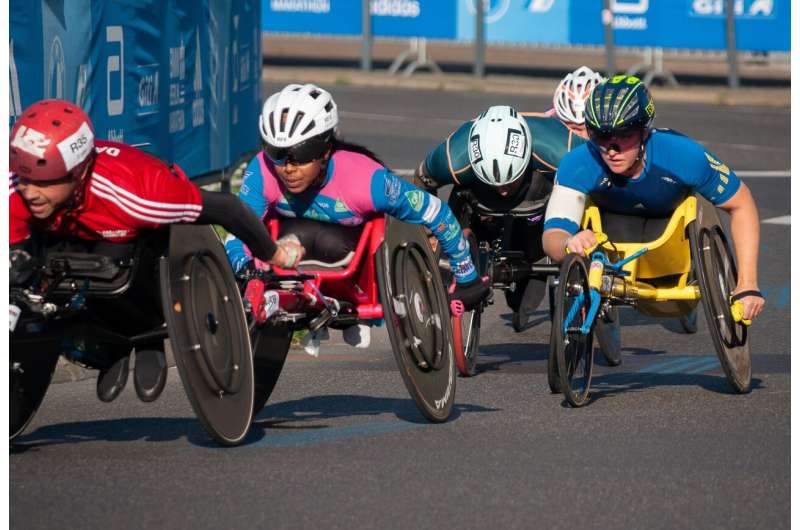
There were fewer but more serious injuries among athletes competing at the Tokyo 2020 Paralympics than at previous Games, with the newly introduced sports of taekwondo and badminton ranking among the sports with the highest injury rates, finds research published online in the British Journal of Sports Medicine.
The findings prompt the researchers to call for preventive measures as well as risk reduction strategies to enhance athlete safety in future Paralympics.
The Tokyo 2020 Paralympic Games were held under unprecedented circumstances, because of COVID-19, note the researchers.
The pandemic also meant there were fewer opportunities for training and meaningful competition in the run-up to the Games—which, combined with the extra infection control measures, may have affected performance and even injury risk, they suggest.
To explore this further, and assess whether the newly introduced sports of taekwondo and badminton posed any particular injury risks, the researchers drew on three sources of information for the 23 sports included in the 15-day period. This included 3 pre-competition days.
The sources included the International Paralympic Committee master list of competitors by age (12-25; 26-34; and 35-75), sex, and sport, plus the daily tally of injuries reported by national medical teams and by clinicians at designated health clinics.
In all, 4403 athletes (1853 women, 2550 men) from 162 countries were monitored during the 15 day period.
During this time, 386 injuries were reported in 352 athletes across all 23 sports, amounting to an overall injury rate of 8%. This is lower than the rates seen in previous Paralympics, including the London 2012 Games (12%) and the Rio 2016 Games (12%).
The sport with the highest injury rate was football 5-a-side, with 16 injuries sustained among 62 competitors (23%), closely followed by the newly introduced sport of taekwondo, with 17 injuries among 71 competitors (21%).
Third in the injury rankings was judo (21 injuries among 138 competitors;15%) and fourth was the other newly introduced sport of badminton, with 12 injuries among 90 competitors (13%).
Most of the injuries were sudden rather than gradual onset: 5% vs. 1%. And most (342) were related to sport participation. More occurred in the period before rather than during competition.
While there was no difference in injury rate between the sexes, older athletes (26-34) were more likely to be injured than their younger peers.
Of the total number of injuries reported, around a third (133; 34.5%) stopped athletes from training or competing for an estimated period of more than a day. This is higher than the equivalent figure (25%) for the Rio 2016 Paralympics.
Twenty one (16%) injuries were classified as moderately serious (8-28 days lost) and 10 (7.5%) were classified as serious (28 days-3 months lost).
Two serious injuries each were recorded for the sports of taekwondo, cycling, and sitting volleyball. The most serious injuries included bone fractures, retinal detachment, pneumothorax (collapsed lung) and knee anterior cruciate ligament rupture.
The highest number of total days lost occurred in athletics (195). But proportionally, the highest number lost was in taekwondo (79), followed by football 5-a-side (49.5), judo (33), badminton (21.5) and goalball (nearly 14).
It’s not clear why there were fewer injuries among athletes at the 2020 Tokyo Paralympics, say the researchers.
“Over the past decade there have been significant developments in the education and practice of sports physicians, which could perhaps translate to improved medical management and injury prevention strategies over time. However, it is unknown whether these improvements alone account for the large reduction in injuries seen in one Games cycle, as observed at the Tokyo Paralympic Games,” they explain.
“While the injury incidence was reduced at the Tokyo Paralympic Games, it appears that injuries sustained were more severe. The frequency of time loss injuries was [also] higher when compared with previous Games,” they add.
And the high injury rates in the newly introduced sports of badminton and taekwondo is of particular concern, especially as taekwondo was also associated with a high number of days lost to training and competition, they point out.
“This finding indicates that prevention practices (e.g., rule changes, better preparation for competition, scheduling, recovery practices) and programs (to address intrinsic risks) are urgently needed,” they conclude.
More information:
Incidence and burden of injury at the Tokyo 2020 Paralympic Games held during the COVID-19 pandemic: a prospective cohort study of 66 045 athlete days, British Journal of Sports Medicine (2022). DOI: 10.1136/bjsports-2022-106234
Journal information:
British Journal of Sports Medicine
Source: Read Full Article
